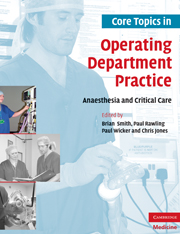Book contents
- Frontmatter
- Contents
- Acknowledgements
- List of Contributors
- Foreword
- Preface
- 1 Introduction: anaesthetic practice. Past and present
- 2 Risk assessment
- 3 ECG monitoring in the recovery area
- 4 The use of cricoid pressure during anaesthesia
- 5 Anaesthetic breathing circuits
- 6 Deflating the endotracheal tube pilot cuff
- 7 How aware are you? Inadvertent awareness under anaesthesia
- 8 Aspects of perioperative neuroscience practice
- 9 Resuscitation
- 10 Intravenous induction versus inhalation induction for general anaesthesia in paediatrics
- 11 Managing difficult intubations
- 12 Obstetric anaesthesia
- 13 Understanding blood gases
- 14 Total intravenous anaesthesia
- 15 Anaesthesia and electro-convulsive therapy
- 16 Mechanical ventilation of the patient
- 17 Perioperative myocardial infarction
- 18 Developing a portfolio
- 19 Accountability in perioperative practice
- Index
- References
18 - Developing a portfolio
Published online by Cambridge University Press: 13 August 2009
- Frontmatter
- Contents
- Acknowledgements
- List of Contributors
- Foreword
- Preface
- 1 Introduction: anaesthetic practice. Past and present
- 2 Risk assessment
- 3 ECG monitoring in the recovery area
- 4 The use of cricoid pressure during anaesthesia
- 5 Anaesthetic breathing circuits
- 6 Deflating the endotracheal tube pilot cuff
- 7 How aware are you? Inadvertent awareness under anaesthesia
- 8 Aspects of perioperative neuroscience practice
- 9 Resuscitation
- 10 Intravenous induction versus inhalation induction for general anaesthesia in paediatrics
- 11 Managing difficult intubations
- 12 Obstetric anaesthesia
- 13 Understanding blood gases
- 14 Total intravenous anaesthesia
- 15 Anaesthesia and electro-convulsive therapy
- 16 Mechanical ventilation of the patient
- 17 Perioperative myocardial infarction
- 18 Developing a portfolio
- 19 Accountability in perioperative practice
- Index
- References
Summary
Key learning points
Definition of a professional portfolio
Structure and purpose of a portfolio
Collecting evidence for the portfolio
Uses of a portfolio for professional, personal, employment and educational purposes
When surrounded by subjects that have a specific clinical focus, it is likely that this chapter will be dismissed as being uninteresting and irrelevant. Compared with the obvious relevance of blood gas analysis or while exploring the complexities of neurological trauma, a portfolio's importance for personal and professional development and its significance for influencing patient care is perhaps less than clear. Developing a professional portfolio is often something that practitioners are intrinsically aware has to be done, but is avoided until it becomes necessary. At that point it is at best a chore and at worst a nightmare as it is often difficult to know where to begin, what to include and how it can be structured.
Nevertheless, the portfolio not only provides evidence of growth and achievement over time, it also allows individuals to be reflective and provides a forum to examine and thus improve practice. Practitioners should also consider it to be more than just a ‘good idea’: it is a ‘must’ for renewing professional registration with either the Health Professions Council (HPC) or the Nursing and Midwifery Council (NMC).
This chapter therefore aims to outline the main purposes of the portfolio, discuss some of the complexities associated with it and provide a few simple principles that may help practitioners in this task.
Information
- Type
- Chapter
- Information
- Core Topics in Operating Department PracticeAnaesthesia and Critical Care, pp. 183 - 190Publisher: Cambridge University PressPrint publication year: 2007
